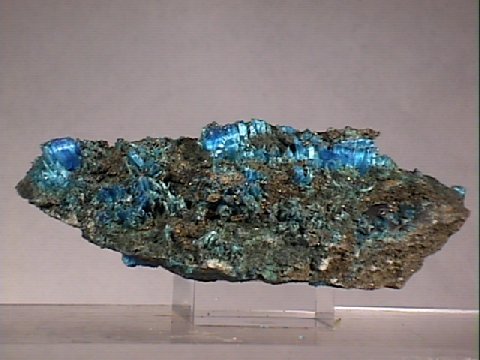
CHALCANTHITE
Specimen clc-4
$ 35.00
Dims: 4.8 x 3.1 x 1.8" (12.2 x 7.9 x 4.5 cm)
Wt: 11.3 oz. (319 g)
Bertha Mine, Dugway District, Tooele County, Utah, U.S.A.
This cabinet specimen consists of scores of small, curved, crystalline Chalcanthite tendrils that extend from a dull, dark brown base rock. These tendrils are only in fair condition at best, as considerable breakage and crushing damage is visible. The tendrils do not generally exceed 0.5" (1.3 cm) in length and show the common, curved parallel structures. They have the characteristic bright blue color and a pearly luster, and are generally translucent.
 Amethyst Galleries' Mineral Gallery MINERALS |
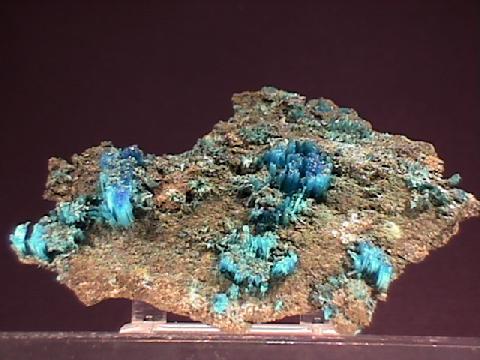
CHALCANTHITE specimen clc-1
$ 25.00
$ 25.00
Dims: 4.0 x 2.6 x 1.3" (10.2 x 6.6 x 3.3 cm)
Wt: 3.86 oz. (109.6 g)
Bertha Mine, Dugway District, Tooele County, Utah, U.S.A.
This hand specimen consists of a dull gray-brown host rock on which rest dozens of Chalcanthite tendrils. These "crystals" have an unusual form that reminds me of "ram's horn" selenite. Their prism lengths are long compared to their diameters often curved, but a few of them do show definite termination faces. Though it is rather difficult to determine damage to them, I do believe that they are in at least moderately good condition. These tendrils achieve lengths of nearly 0.5" (1 cm) and tend to be gathered in clusters of parallel crystals (see the close-up image). Most of them, however, do not exceed 0.2" (5 mm). All have a moderate royal blue coloration that is one of their primary characteristics, and the luster of their prism faces is almost silky. Individual crystals may be transparent and quite clear, but the clusters are generally translucent. I am not certain, but I believe that these crystals formed due to huge evaporation mining processes that are common in the more arid climates of western and southwestern U.S.
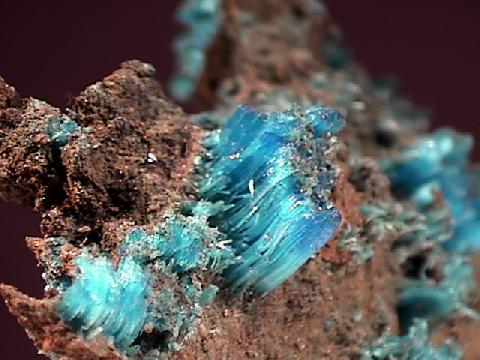

clc-1 ($ 25.00)
Bertha Mine, Dugway District, Tooele County, Utah, U.S.A.
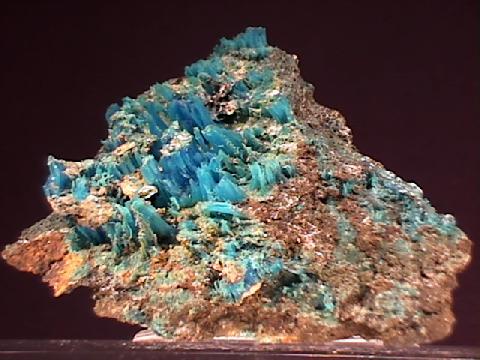
CHALCANTHITE specimen clc-2
$ 27.00
$ 27.00
Dims: 3.2 x 2.7 x 1.2" (8.1 x 6.9 x 3.0 cm)
Wt: 3.81 oz. (108.0 g)
Bertha Mine, Dugway District, Tooele County, Utah, U.S.A.
Dozens of slightly curved Chalcanthite crystals rest on the brown host rock of this hand specimen. These crystals appear to be in moderately good condition and reach lengths of 0.5" (1.3 cm), though many of them are smaller than that. All have what appears to be a triclinic prismatic form, but their general habit most closely resembles that of "ram's horn" selenite. All have a bright royal-blue coloration and a silky luster along their prism lengths, and one or two may even have natural cryastalline terminations. All are at least translucent, and a few of the better-formed, thinner crystals may be dimly transparent. The base rock is unusual in the fact that many tiny pyrite and chalcopyrite crystals are embedded in its underside. Like the previous specimen, this piece was most likely formed through an evaporation mining process.

clc-2 ($ 27.00)
Bertha Mine, Dugway District, Tooele County, Utah, U.S.A.

$ 75.00
Dims: 3.2 x 1.5 x 1.3" (8.1 x 3.8 x 3.3 cm)
Wt: 2.89 oz. (81.8 g)
Broken Hill Mine, New South Wales, Australia
Likely the largest single piece of Chalcanthite that I have seen, this specimen consists of an amorphous chunk of the copper sulfate mineral. I can see crystalline tendencies on a few small protrusions, but the main body of material is rough and amorphous. Fresh breakage surfaces at each end of the piece show air bubbles that are arranged in a curved, circular pattern around a larger, deeper shaft that runs into the piece. The irregular shapes of these shafts make me think that they are natural in origin, and they do not appear to be connected, as I dropped a tiny grain of sand in one end, and it did not come out of the other. The material has the classic bright azur-blue of its species and shows a bright pearly luster on its fresh breakage surfaces. It is definitely translucent, though the thickness of the piece at its center makes it quite dim. There is no host rock present.

Broken Hill Mine, New South Wales, Australia

CHALCANTHITE specimen clc-4
$ 35.00
$ 35.00
Dims: 4.8 x 3.1 x 1.8" (12.2 x 7.9 x 4.5 cm)
Wt: 11.3 oz. (319 g)
Bertha Mine, Dugway District, Tooele County, Utah, U.S.A.
This cabinet specimen consists of scores of small, curved, crystalline Chalcanthite tendrils that extend from a dull, dark brown base rock. These tendrils are only in fair condition at best, as considerable breakage and crushing damage is visible. The tendrils do not generally exceed 0.5" (1.3 cm) in length and show the common, curved parallel structures. They have the characteristic bright blue color and a pearly luster, and are generally translucent.

clc-4 ($ 35.00)
Bertha Mine, Dugway District, Tooele County, Utah, U.S.A.

CHALCANTHITE specimen clc-5
$ 45.00
$ 45.00
Dims: 4.9 x 3.6 x 1.8" (12.4 x 9.2 x 4.5 cm)
Wt: 1 lb., 0.9 oz. (480 g)
Bertha Mine, Dugway District, Tooele County, Utah, U.S.A.
This cabinet specimen consists of dozens of short, curved Chalcanthite tendrils that extend from a dull, brown host rock. These tendrils do not exceed 0.8" (2 cm) in length and do not show any definite triclinic form - they are instead aggregated into curved growth structures that are by far the most common for this specie. There is a considerable amount of breakage, as the tendrils are very delicate, but many are in good condition. Their bright blue color and silky-to-pearly luster are standard, and all are translucent.
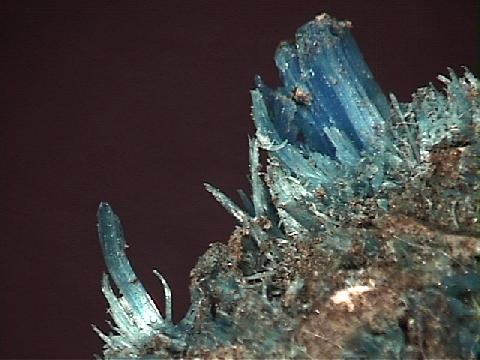

clc-5 ($ 45.00)
Bertha Mine, Dugway District, Tooele County, Utah, U.S.A.

CHALCANTHITE specimen clc-6
$ 50.00
$ 50.00
Dims: 4.7 x 2.7 x 1.5" (12.0 x 6.9 x 3.9 cm)
Wt: 6.0 oz. (170 g)
Bertha Mine, Dugway District, Tooele County, Utah, U.S.A.
Dozens of curved Chalcanthite tendrils extend from the brown base of this cabinet specimen. These tendrils appear to be in good condition and reach lengths of about 0.5" (1.3 cm). Though not showing any actual triclinic tabular shapes, they are definitely crystalline in habit. All have the standard bright blue color and waxy luster of the specie, and are translucent.
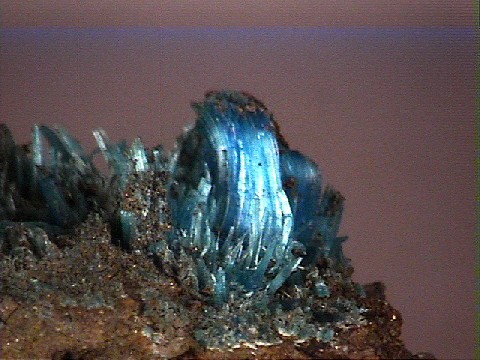

clc-6 ($ 50.00)
Bertha Mine, Dugway District, Tooele County, Utah, U.S.A.
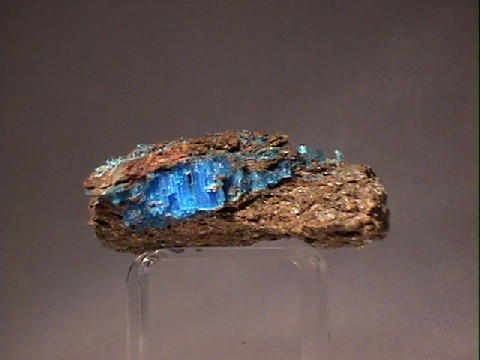
CHALCANTHITE specimen clc-7
$ 75.00
$ 75.00
Dims: 4.2 x 3.3 x 1.3" (10.7 x 8.4 x 3.4 cm)
Wt: 9.2 oz. (262 g)
(likely Tooele Mine, Utah, U.S.A.)
This large cabinet specimen consists of a crumbly, rust-brown base rock from which extend several Chalcanthite formations. Each of these formations is made up of many partly intergrown Chalcanthite "tendrils" that are in fair to good condition, as most of them are broken. These tendrils do not exceed 0.4" (1.0 cm) in length and show no definite triclinic form, as the tendrils are uneven and often curved. Their bright blue coloration and waxy luster are standard for the specie, and all are translucent.

clc-7 ($ 75.00)
(likely Tooele Mine, Utah, U.S.A.)
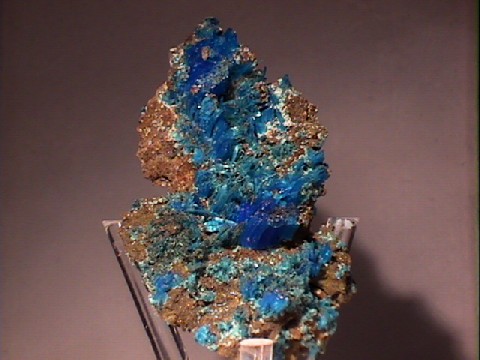
CHALCANTHITE specimen clc-8
$ 100.00
$ 100.00
Dims: 5.0 x 2.9 x 1.5" (12.8 x 7.3 x 3.7 cm)
Wt: 6.5 oz. (184 g)
unknown (likely Tooele Mine, Utah, U.S.A.)
The brown base rock of this cabinet specimen holds scores of curved Chalcanthite tendrils, many of which are intergrown into parallel formations. These tendrils reach 0.7" (1.8 cm) in length and are in very good condition as a whole. They do not show any definite monoclinic form, but take on the columnar, aggregated formations that are common for the specie. They have the classic bright blue color and dull silky luster, and are translucent.
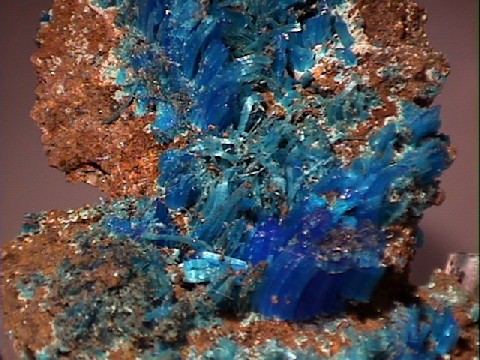

clc-8 ($100.00)
unknown (likely Tooele Mine, Utah, U.S.A.)
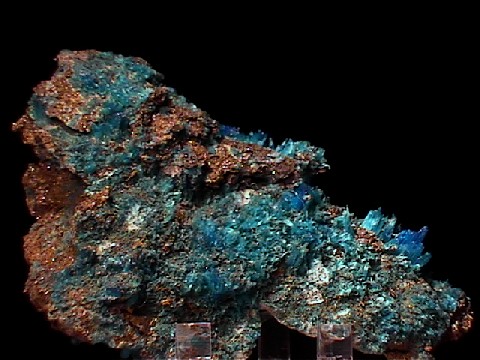
CHALCANTHITE specimen clc-9
$ 45.00
$ 45.00
Dims: 5.1 x 3.2 x 1.9" (13.1 x 8.1 x 4.7 cm)
Wt: 13.5 oz. (382 g)
unknown (likely Utah, U.S.A.)
Hundreds of tiny Chalcanthite aggregates rest on the dull, brown base of this cabinet specimen. These aggregates stem from Chalcanthite's triclinic form and are generally curved and irregular. They do not tend to exceed 0.5" (1.3 cm) in length and are generally in very good condition. The Chalcanthite shows the classic bright blue color and pearly/silky luster of its specie, and is translucent.

clc-9 ($ 45.00)
unknown (likely Utah, U.S.A.)

CHALCANTHITE specimen clc-10
$ 90.00
$ 90.00
Dims: 8.7x5.6x2.2" (22.2x14.2x5.6cm)
Wt: 31 oz. (877g)
Aztec Mine, Santa Cruz County, Arizona, USA
Its too bad that chalcanthite is water soluable and extremely fragile, because specimens such as this are very beautiful. Dozens of clusters of deep blue, transparent, silky chalcanthite crystals contrast nicely against the off-white to light brown host rock. Under a loupe, the crystals look even better, because they have excellent clarity and that wonderful blue color. To the naked eye, the clarity is obscured by the silky appearance of the clusters of fine crystals, although that is a pleasing optical effect. Specimens such as this should be stored in a controlled humidity container (preferably dry), as cycles of humidity changes will eventually break down the crystals.
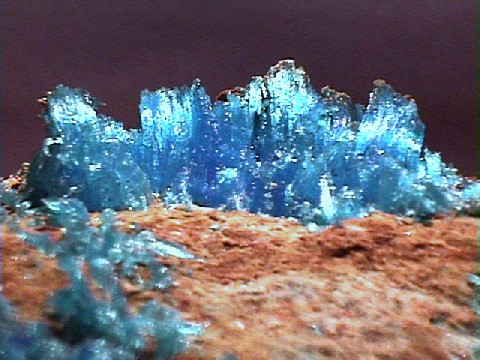

clc-10 ($ 90.00)
Aztec Mine, Santa Cruz County, Arizona, USA
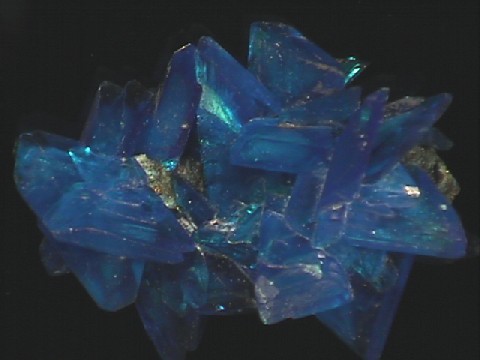
CHALCANTHITE specimen clc-12
$ 35.00
$ 35.00
Dims: 2.76x2.21x2.17" (7.02x5.61x5.52cm)
Wt: 2.98oz (84.2g)
Aztec Mine, Santa Cruz County, Arizona, USA
This specimen is so colorful as to appear artificial. It was created in a copper mine, where hydrated copper sulfate precipitates out of solution as chalcanthite crystals on nearly any available surface, here a nondescript chunk of rock. It can be deemed artificial, as the solution was created by the actions of the miners, yet it can also be deemed natural, as the crystals grew on their own, and not in a place that the miners intended. The crystals are large and prismatic, and are generally transparent but with cloudy areas. Crystals such as these form within a solution, while another common form grows as curved crystals formed in air from a solution seeping from a porous rock.

clc-12 ($ 35.00)
Aztec Mine, Santa Cruz County, Arizona, USA
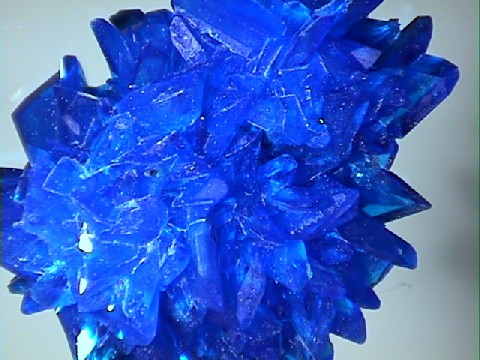
CHALCANTHITE specimen clc-14
$ 32.00
$ 32.00
Dims: 2.87x2.46x2.05" (7.28x6.26x5.21cm)
Wt: 3.43oz (97g)
Aztec Mine, Santa Cruz County, Arizona, USA
This chalcanthite specimen has deep blue, transparent crystals that have various degrees of cloudiness. They are well-formed, although many of the crystals show minor damage. The crystals precipitated on a host rock in a copper mine, under solution. There is some evidence of "artificiality", in that a small thread can be seen protruding from one of the upper crystals. It appears that the host rock was suspended by this thread in the mine, to make it easy to retrieve a chalcanthite specimen.
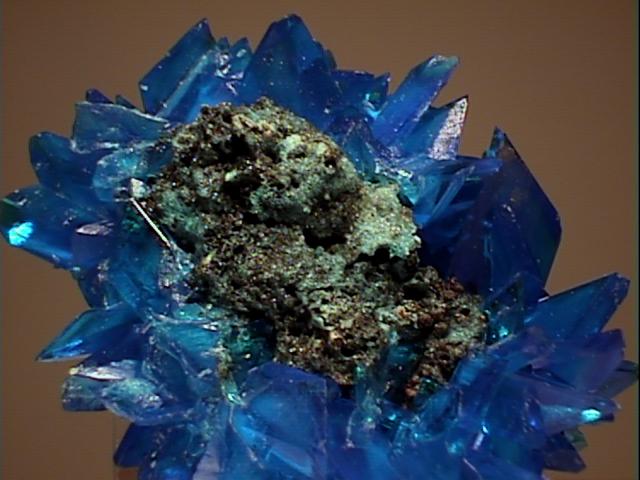

clc-14 ($ 32.00)
Aztec Mine, Santa Cruz County, Arizona, USA
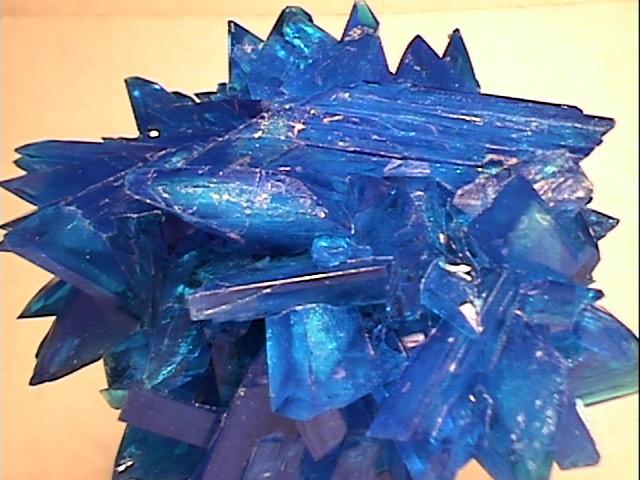
CHALCANTHITE specimen clc-16
$ 30.00
$ 30.00
Dims: 2.81x2.29x1.79" (7.13x5.82x4.53cm)
Wt: 4.41oz (124.7g)
Aztec Mine, Santa Cruz County, Arizona, USA
This chalcanthite specimen from the Aztek mine is likely another "encouraged" crystal. I suspect that a stone was suspended in the outflow of the mine, resulting in this pretty specimen that has reasonably clean chalcanthite crystals growing from all sides of the host rock. Pretty chalcanthite crystals coat nearly every surface at the outflow point of the mine. There is no sign of an attachment point. The crystals are deep blue and transparent, with a rhombic shape.
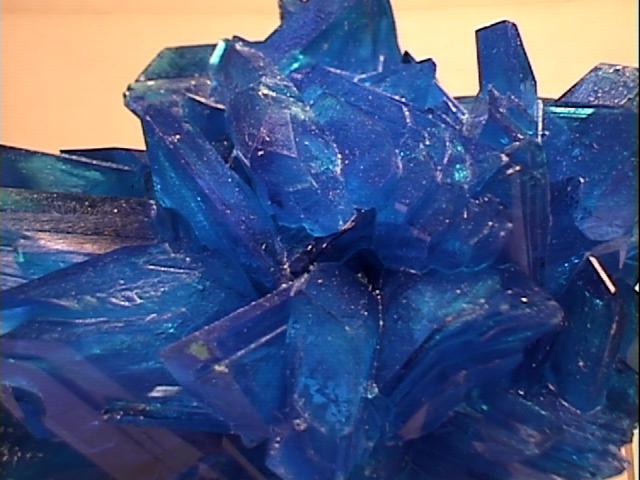

clc-16 ($ 30.00)
Aztec Mine, Santa Cruz County, Arizona, USA

$ 300.00
Dims: 8.52x6.12x4.43" (21.64x15.55x11.26cm)
Wt: 46.56oz (1320g)
Aztec Mine, Santa Cruz County, Arizona, USA
Although this specimen is a bi-product of a copper mining operation, it is still a spectacular specimen displaying an enormous crystal of chalcanthite. It is, of course, a bright blue color with a vitreous luster. The huge chalcanthite crystal is part of a cluster of large crystals, and there are several more clusters of smaller crystals scattered over the host rock. Speaking of the host rock, it appears to be a sandstone cemented together with a sky-blue mineral that looks like chrysocola, but a close examination reveals tiny transparent crystals, suggesting that they are cyanotrichite.


Aztec Mine, Santa Cruz County, Arizona, USA